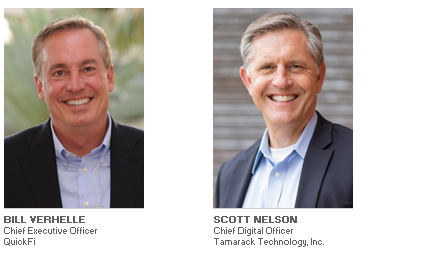
“You can have it in any color as long as it's black.” – Henry Ford on his Model T.
This famous Henry Ford quote along with, “If I had asked people what they wanted, they would have said faster horses,” are sometimes used as examples of Ford’s merciless indifference to customer preferences in the early days of the auto industry. The latter is also often cited as an example of the difficulty in relying on traditional customer feedback methods during periods of transformative technology advancement. How could a customer possibly know they might prefer an Apple iPod when they have only seen a Sony Walkman? Both interpretations reveal important challenges facing business innovators today.
Ford understood his customers. He used his instinctive empathy and a new manufacturing vision to build a company that uniquely met society’s needs. Black paint dried fastest and one color meant lower costs on his new assembly lines. In 1908, people needed affordable, “horseless” transportation. Color was not an affordable concern – reliable value was what mattered. Ford designed a manufacturing company and product that delivered what customers valued most. Ford employed design thinking, long before the term was coined.
Empathy is the cornerstone of design thinking. Empathy is not an innate skill for all business professionals, but fortunately techniques for practicing and implementing empathy, as Ford did, now exist. They are referred to as Design Thinking. IDEO founders David Kelly and Tim Brown are most often credited with defining design thinking and its practice, but it has been at the center of innovation and business success long before their teachings. The standard bearer of design thinking more recently has been and continues to be Apple. Like Ford, Steve Jobs famously said, “People don't know what they want until you show it to them.” Empathy, not indifference, has maintained Apple’s design thinking culture which continues to surprise us with innovative products. Often after experiencing unanticipated new Apple products, we find we cannot live without them.
What exactly is design thinking? How does a company deploy it a pragmatic way?
Like business strategy, the design thinking ecosystem has many consultants with good teachings, but it also has everyday practitioners that give us examples to follow and successes to which most successful business innovators aspire. Let’s explore some of these teachings and pragmatic approaches to using it.
What is Design Thinking?
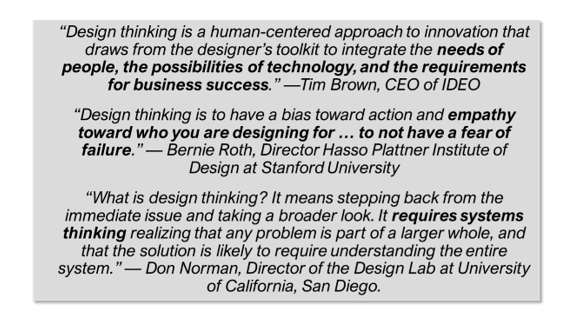
These three quotes from IDEO Design Thinking define a practical application for the formalism. Brown’s quote defines a mindset that is visualized by the Innovation Venn (figure below) – simultaneously building customer desirability, technical feasibility and financial viability. The Design Thinking mindset is about “AND”, not “OR”. The Venn helps a business judge the value of an idea or offering by how well it is centered, i.e., how well it delivers desirability AND feasibility AND viability.
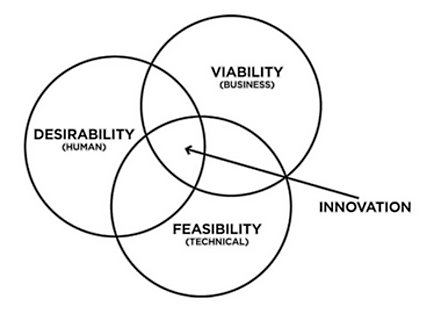
The Innovation Venn describes the mindset of Design Thinking.
This mindset must be converted to action and that leads us to three principles: empower customers with empathy, use a system thinking process focused on improving the customer experience and build a team culture without the paralyzing fear of failure.
Empathy: Empowering Customers
Customers want to be empowered. They want the ability to solve their own problems, grow their businesses and do so as quickly and easily as possible. Ford empowered people to get where they needed to be; Netflix empowers people to entertain themselves when and where they want; and Apple enables people to communicate and share when, where and with whom they want.
Our objective must be to empower via empathy. We’ve all heard “feel their pain” and “walk in their shoes.” In the equipment finance space, service providers have long focused on lenders and their challenges with accounting, regulations and risk management. This is good practice to optimize the existing business model for the cost advantage of the lender, but if we are going to help lenders innovate and create new business models, we must better serve and empower the borrowers they serve.
At Tamarack, for example, we do this by incorporating the operational data streams from the equipment to better understand how borrowers are using and maintaining the financed equipment to pursue their important business objectives. This is how connected equipment manufacturers are using the IoT to empower their customers. Operational data measures activity, activity measures intent and by understanding operational intent we more fully understand the borrowers’ important interests such that we may better help them improve and grow their businesses.
Process: Systems Thinking and Customer-first
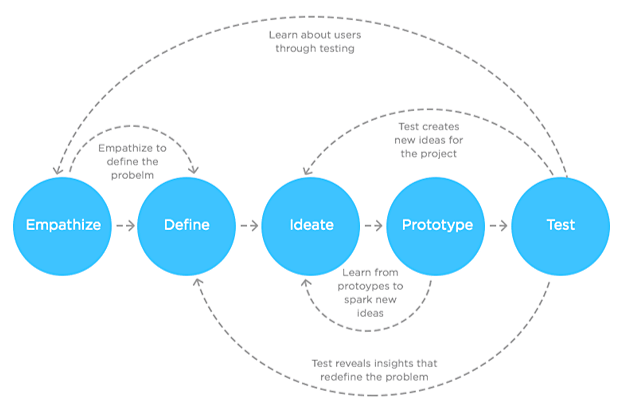
The design thinking process is iterative and non-sequential. Although the diagram reads left to right, the flow of people, tasks and information will be more circular. The steps must be performed in a systems frame of view and with the discipline to document and learn during the process. The team must include a systems thinker who can see the full context of the problem – from customer inquiry to equipment disposal – to avoid sub-optimal solutions. The financing life cycle does not end with origination. From a risk and from a borrower experience point of view, that is just the beginning.
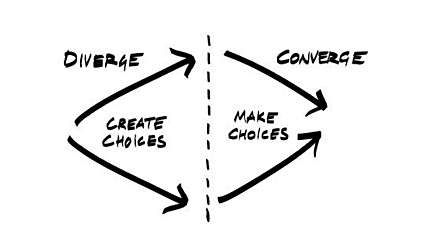
Then there’s ideation. How often have you heard “Focus!” or “We need to get back on subject!” during a brainstorming session? Design thinking teaches that the process creates choices before making choices. Limitations on ideation reduces the impact because the critical thinking necessary to prioritize and select across a full set of choices is missed. Many managers feel focus is a key to efficiently getting things done, but an innovation process must diverge before reconverging and prompting action.
QuickFi contemplates both borrower needs and borrower capabilities, “empowering” borrowers in the process. The result is business equipment financing and leasing available to borrowers 24/7, on a mobile device, with nearly instant credit underwriting, structuring, digital documentation and funding – all initiated and driven by the borrower without lender involvement. The offering further empowers the borrower with transparency, including disclosed interest rates on all business loans, no fees, no additional costs, and in most cases, no prepayment penalties for early payoff. Delivering these borrower experiences required constructing an entirely new business model, leveraging feasible new technologies all undertaken and developed with design thinking.
Organizational Design Considerations – Importance of Team-based Structures
Before discussing culture, we believe organizational design challenges should be addressed to create an environment suitable for design thinking success. Regulated industries, like healthcare and finance, often struggle with organizational design challenges. Decades of business strategies based on “cost leadership” led to siloed businesses with hierarchical, command-and-control elements. Unfortunately, these structures tend to be poorly suited to innovation and design thinking.
A team-based structure is more conducive to design thinking. At its core, design thinking is about deeply understanding and empathizing with the customer and implementing new ideas to improve that customer’s experience. Small, cross-functional, team-based organizational structures are excellent for this type of work. Most technology companies, including some of the largest companies in the world today, are organized in teams. Amazon often talks about two pizza teams (cross-functional teams small enough to be fed with just two pizzas).
The challenge for more traditional company structures is that decision-makers in hierarchical organizations are often far removed from customers, making it difficult to empathize and effectively implement new ideas. The establishment of creating a diverge-converge loop of iterative trials becomes challenging or impossible outside the scope of a small, empowered team. And the values in more traditional organizations typically prioritize a lack of mistakes over employee efforts designed to stimulate change.
Culture – Without Fear of Failure
Consultants of business innovation eventually discuss culture. Culture is important, but also abstract and often hard to measure, fully understand and change. Design thinking as a process brings focus to the actions the corporate culture must tolerate and eventually foster. Culture improvements can also be iterative, measured and systematically improved. Freedom to fail and learning fast from failure are representative of the cultural or philosophical shifts that better serve design thinking initiatives. Failure can have significant consequence, both physical and financial. And there are ways to distinguish small, helpful failures leading to process improvement or business model innovation, from more traditional failures (such as credit losses) companies must minimize to remain solvent. Distinguishing between the two types of failure and encouraging small failures with the potential for business improvement is important to foster design thinking and innovation.
Few companies in any industry have successfully transitioned to a digital model when confronted with new, disruptive entrants. We saw this in retail when the leading retailer for decades, Walmart, was repeatedly unable to establish a coherent online presence after Amazon continued gaining market share from the previously unassailable retailer. There is typically no path to transition a business from the legacy model to the new digital model. The few successful companies making the transition, as Walmart was eventually able to do after many challenging years, typically involve a legacy player buying or starting and growing an entirely new digital businesses, outside of the existing business.
QuickFi was started with an organizational design and cultural elements that enable design thinking. But even with a team-based structure and a corporate culture that encouraged risk taking, engaging a new digital model is quite difficult. QuickFi was started from scratch, outside the confines of an existing equipment finance business. The new business strategy was a blend of analysis and selection of emerging new technologies, including artificial intelligence, blockchain, facial recognition, mobile and cloud technologies, and a deep dive into design thinking. Since its founding in early 2018, Mark Tomaselli, QuickFi President and Chief Technology Officer, urged the QuickFi team to burn their bridges and rebuild an entirely new, digital business model from scratch – in a way that would be most responsive to the business borrowers they serve.
Few know when customers may be wrong about wanting “a faster horse.” But transformative advancements are more and more common as technologies advance exponentially and enable new ways to do business at pace unprecedented in human history. Successful business implementation of these rapidly emerging new technologies cannot happen without empathy. Design Thinking provides a mindset, a process, and the organizational tenants to successfully understand unstated customer and marketplace needs and create new business models to meet them.
This is the opportunity of design thinking. It provides a framework to help leverage transformative advancements in technology to create a dramatically better business model to serve customers. A culture of empathy for borrowers, without fear of failure, encompassing new technologies, enables equipment finance companies to consider entirely new ways to conduct business. This strategic implementation of emerging technology with a customer focus, is the essence of all business innovation.
